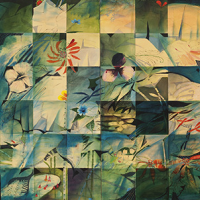CHARLES BLACKMAN The Chess Garden

'The chess-board painting… represents the criss-cross quiz of what you see in the jungle, which is a game of chess between the inhabitants, whether it’s the cicadas, or the snakes, or the waterdragons, or the echidnas or even the spiders. I remember going down the path one day to my studio and encountering a large grey spider and a wasp having a fight. The wasp won. When I came back there was nothing but eight legs.'1
The crucible in which Charles Blackman forged his career is without doubt his figurative subjects, notably the hauntingly beautiful images of women and girls in his two iconic 1950s series based on Melbourne schoolgirls and Lewis Carroll’s book ‘Alice in Wonderland’. However, his art addresses a wide range of subjects, and its enduring popularity hinges upon this versatility. During the late sixties and early seventies Blackman first experimented with new non-figurative subjects including images of beaches, rainforest gardens and the recurring white cat.
In 1980 Blackman purchased land at Buderim on Queensland’s Sunshine Coast, where he established a winter studio and dwelling with his second wife, Genevieve de Couvreur, amongst the verdant subtropical surrounds. Here amongst this ‘Eden’ Blackman created a unique suite of paintings within his oeuvre that are transformative and exciting. ‘Whereas in earlier times, when Blackman shut himself up within nature, it was primarily within human nature and his own psyche, now when he shuts himself up within nature, nature is the natural environment and it is of art, rather than psychology that he thinks.’2
The Chess Garden 1984-5 is a significant work from Blackman’s years at Buderim. A mesmerising patchwork of flowers and foliage, sunlight and dappled shade, each panel is homage to an aspect of Blackman’s garden at Buderim. A tangle of hibiscus, jasmine, fern fronds and creeping vines, is expertly composed over a mathematically precise grid of squares; the tonal changes and arrangement here mimicking a chess board. This playful approach to composition allows Blackman to explore the minutiae of his surrounds rather than the scene as a whole, zooming in on the exotic blooms and pigments; the fragments of the whole. Paradoxically, the strict precision of the grid pattern facilitates freedom in Blackman’s treatment of space and time. In several parts of the work, adjacent squares maintain continuity in space, by depicting a single subject over multiple squares. Temporal continuity is broken however, as day gives way to night, or more subtly, late afternoon stands next to the crepuscular. This complex use of light and time attains coherence through the effective use of the grid.
Blackman’s discovery of Japanese art during the early eighties is keenly felt in his approach to style during these years. The Chess Garden recalls the translucency of a Japanese screen, the light seemingly coming from behind the work, while the imagery is applied with calligraphic precision without overwhelming the warm salmon tone of the undercoat.
The Chess Garden’s status as a major work within Blackman’s oeuvre was confirmed with its inclusion in the National Gallery of Victoria’s retrospective exhibition, Charles Blackman: Schoolgirls and Angels which traveled to the Art Gallery of New South Wales, the Queensland Art Gallery and the Art Gallery of Western Australia between 1993 and 1994.
Footnotes
1. Charles Blackman cited in St John Moore, F. (1993), Charles Blackman: Schoolgirls and Angels [Exhib. Cat.], National Gallery of Victoria, Melbourne, p.127
2. Ibid, p.8
Alison Burns. B.A. Hons